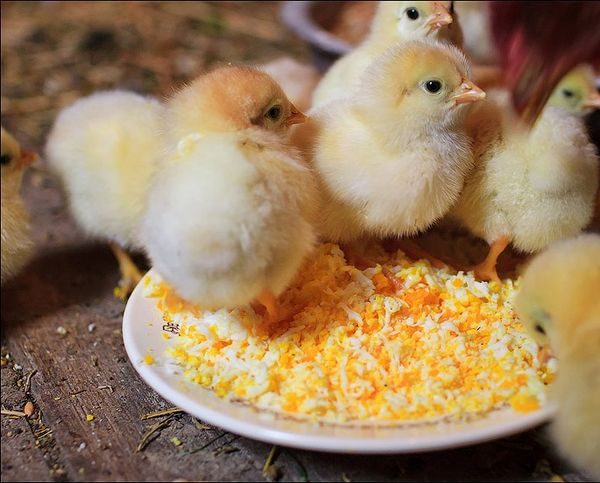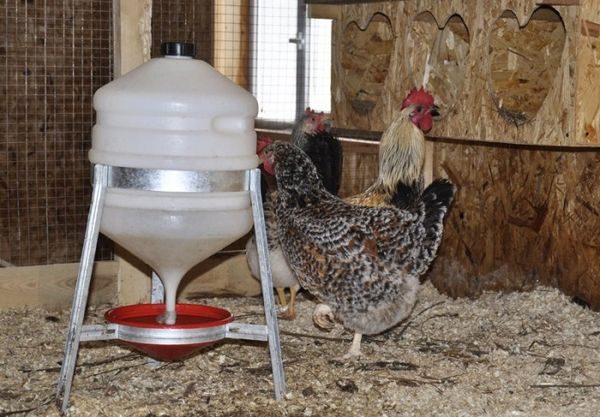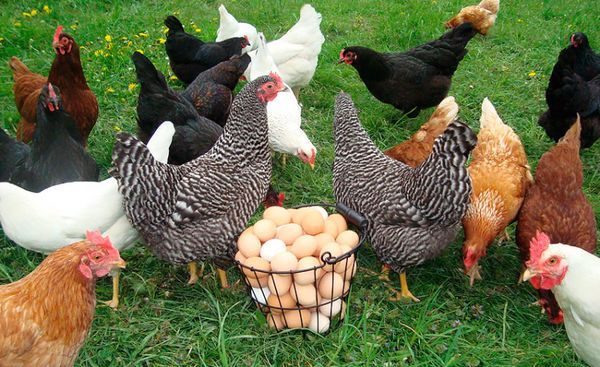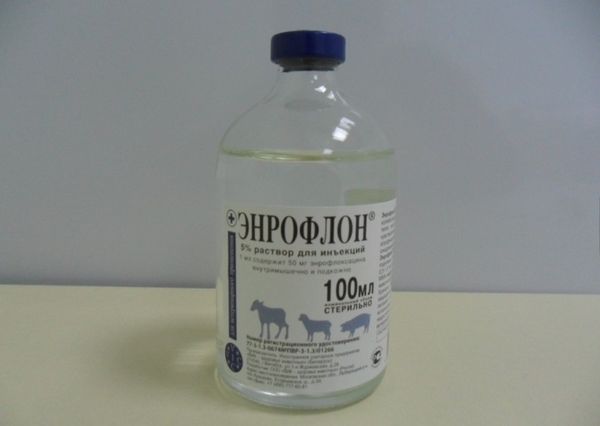Breeding birds is a troublesome thing that requires a special approach. After all, birds, as well as other animals can suffer from infectious diseases.
Sometimes diseases can go away on their own, but not always. There are cases when the infection does not go anywhere, but rather goes further and further, causing a strong defeat until the death of the bird.
Therefore, we should not forget that birds, especially from the first days of life, should definitely be given enroflon medicine both for the treatment of diseases and for prophylactic purposes. This antibiotic will help prevent and cure infections.that as a result will help grow healthy offspring.
So what is this drug? What are the features and how should be used for birds? Let's find out the answers to all the questions of interest and examine in detail the properties of the drug.
Table of contents
What diseases are used in veterinary medicine?
Enroflon has an antimicrobial effect, is used to rid infections and to prevent viral diseases in birds.

The drug is taken with the following indications:
- Different degrees microplasmosis;
- Salmonellosis from the first stages and up to heavy;
- Enteritis;
- Colibacteriosis;
- Bronchopneumonia;
- Enzootic pneumonia;
- Atrophic rhinitis;
- Secondary infectious diseases.
The tool is given to the chicks in the first 10 days of life, for the prevention of disease and the preservation of the livestock of birds.
What are the dosages in%
In various digestive disorders and as a preventive measure, birds are given a 5% or 10% enroflon solution. 5% solution It is added to feed or water at the rate of 0.5-1 ml per 1 kg of live weight of the bird.
In its purest form, they are given to birds at the rate of 2.5-5 mg per 1 kilogram. 10% solution should be added to water or feed at a dosage of 0.5 ml per kilogram of body weight of the individual. In pure form, the 10% drug is given in doses of 2.5-5 mg per 1 kg of the mass of the individual.
But these are still general indicators of taking medicine for broilers in veterinary medicine, and there are serious cases when the drug should be taken in large proportions and in a different way.

Therefore, it is worth considering the rules for taking medicine for chicks and adults separately, this will help to avoid serious problems and raise healthy offspring.
How to apply enroflon for chicks
For chickens
Enroflon for chickens is applied from the first days of appearance. The medicine is an excellent tool for the prevention of newborns from infectious diseases.Due to prevention, chicks can be warned against many infections which can hit almost all the livestock of individuals in a day.
These days, chicks are most susceptible to infectious diseases - gastrointestinal problems, respiratory diseases and diseases of the joints.
The use of enroflon for chickens provides the following indicators:
- Beneficial effect on microflora digestive system
- Saturation of the body helpful components;
- During colds, the medicine has anti-inflammatory exposure and reduces the risk of viral infections;
- Helps to get rid of colibacillosis, mycoplasmosis, salmonellosis and other infectious pathologies.

The drug is taken both for prophylactic purposes and for the first symptoms of salmonellosis, enteritis, colibacillosis, bronchopneumonia, mycoplasmosis and other diseases.
During this period, the chicks are given 10% medicine, it is poured into water in dosages - 0.5 ml per 1000 ml of water.The course of medical procedures is from 3 to 5 days. It is worth remembering when salmonellosis medication is given in twofold dosages.
For poults
Poults, starting from the 5th day of life to 10, often suffer from infectious diseases, this is due to a weak immune system. During this period, the chicks are weak and exposed to microbes. The chicks suffer from digestive disorders, at this time they are worried about diarrhea, they have colds, viral pathologies.
The drug is added to the water in doses of 0.5 ml per 1 liter of water. If a 10% solution is given, then 1 ml of the medicine is added to 1 liter. The course of treatment is 3-5 days.
For goslings
Geese are considered hardy birds and rarely get sick. However, there are infectious diseases among the chicks that cause serious problems.

Goslings in the first days of life suffer from the following ailments:
- Pasteurellosis;
- Salmonellosis;
- Enteritis;
- Gastrointestinal infections;
- Viral respiratory diseases.
Therefore, goslings, like chickens, are prevented with the use of enroflon. It should be added to water in proportions of 0.5 ml per 1 liter of water. You can give a 5% and 10% solution. The treatment period lasts from 3 to 5 days.
Application for other birds and broilers
For chicks of other birds, the use of the drug has the same meaning. It is given to birds during prophylaxis, to enhance the immune system of individuals, as well as for the treatment of infectious pathologies - microplasmosis, salmonellosis, enteritis, colibacteriosis and other viral infections.
The drug is diluted in water - 0.5-1 ml of the drug is added to 1 liter. You can give a 5% 10% drug. The treatment period lasts from 3 days to 5 days.
Instructions for use for adult birds
For adults of chickens, geese, ducks, guinea fowls, pigeons and other species of birds, enroflon is given for the indication of microplasmosis, colibacillosis, salmonellosis, enteritis, bronchopneumus and other infectious and respiratory pathologies.

The use of the drug provides the following indicators:
- Boost immune systems;
- Caution against the occurrence of many serious of infections;
- Performance improvement digestive systems;
- Saturation organism nutrients and nutrients;
- During catarrhal and viral respiratory diseases, the drug reduces inflammatory processes and thereby eliminates the harsh consequences.
Instructions for use: for adults, the medicine is given by the oral route, that is, it is added to water and the bird is drunk with this solution. The tool is added to the water at the rate of 0.5-1 ml per 1 liter of water. During salmonellosis, the dose of the drug is doubled.
The preparation should be prepared only for the amount of water consumed per day, but not more, if the water with the medicine is longer than one day, the effect of the agent is much lower. The treatment period lasts from 3 to 5 days. During this period, water should be given only with enroflon.
Side effects
At observance of the recommended doses of side effects is not observed. Sometimes chickens may have allergic reactions to the components of enroflon, namely to fluoroquinolones. In these cases, the use of the drug should be immediately discontinued and antihistamines should be given instead.
Contraindications
Enroflon is contraindicated during damage and severe impairment of the kidneys and liver.
It is also not recommended to give laying hens to eggs if eggs are eaten. Because the active component enrofloxacin falls into the composition of eggs. If the birds suffer from infectious pathologies and treatment with enroflon is vital, then it is better to stop eating eggs at the time of medical procedures.

It is not recommended to combine with the following medications:
- Prohibited take tetracycline, macroclide, levomycetin, with bacteriostatic type antibiotics;
- In no case do not need to give with theophyllinesteroids and anticoagulants;
- Not desirable to give together with iron-containing agents, sucralfate and antacid substances, as well as aluminum, magnesium and calcium. This may reduce the effect of enroflon. It is best to give the drug for 1-2 hours before taking or after 4 hours of taking these funds.
Attention, poultry meat that was treated with enroflon medicine should be consumed 11 days after treatment.If slaughter was made earlier, then it is better to add meat to the feed of other animals or from it you can make meat and bone meal.
Pharmacological properties
The main active ingredient is enrofloxacin. This component is included in the group of fluoroquinolones and has a wide range of antibacterial and antimycoplasma action. Entrofloxycin has a suppressive effect on many bacteria and viruses.
Immunity of viruses and bacteria to enroflon develops rather slowly, because the mechanism of antimicrobial effects of enrofloxacin is directly related to the inhibition of the enzyme, which affects the replication of the DNA helix in a bacterial cell.
The drug is quickly absorbed into the stomach and then enters other organs and cells of the body. Is excreted along with urine or bile.
The treatment of poultry is a laborious process that must begin in the very first stages. Better to start give the drug from the first days of life chicks, to enhance the immune system of individuals and to warn against serious pathologies.
The main thing during the use of enroflon to observe the rules of admission and indications. Remember, proper care and timely prevention of all kinds of infectious diseases - the key to healthy offspring!

"At this time there are many bugs on earth that can carry infections."
What infections do bugs carry?
The article is crazy stuff. Do not believe!
Probably, they did not hear about the histomoniasis, this sore is not terrible for smokers, but the poults are dead
In the childhood, this writer of this advertising opus was forgotten to be drunk with antibiotics according to the “schedule”, and now his inflamed brain produces “schedules” for chicks to drink from birth with ANTIBIOTICS ... ANTIBIOTIC - anti bio
Who to believe? What's wrong?